Located on the banks of the Sarayu River in the Indian state of Uttar Pradesh, Ayodhya, previously known as Saketa, serves as the administrative headquarters for both the Ayodhya district and the Ayodhya division. Ramalalya’s pran pratistha have been performed in Ayodhya on 22 January 2024. If you are also planning to visit Ayodhya, then you will get complete information. In addition to the Ram temple, Ayodhya is adorned with various temples and pilgrimage sites that hold significant spiritual importance, creating a list of sacred destinations for visitors.
How to Reach?
It is well connected by road and rail. The nearest railway station is Ayodhya Junction. From Feb-2024 flights will start from India’s most popular airports. Apart from Ayodhya Airport, there is another nearest airport Lucknow which is around 152 km at distance. Gorakhpur, Prayagraj, and Varanasi airports are also nearby airports which are within 230KMs. You can get a taxi to Ayodhya from the airport.
Best Places to Visit in Ayodhya
1.Ram Lalla Temple

It is one of the most famous religious places to visit in Ayodhya. The Ram Janmabhoomi, a sacred site of great significance, is the traditional location believed to be Lord Ram’s birthplace according to Hindu tradition and the epic Ramayana. Despite being a center of dispute since the destruction of the Babri Masjid, the Ram Janmabhoomi Temple remains a major attraction in Ayodhya, revered as the birthplace of Lord Ram, the seventh incarnation of Lord Vishnu. Originally built at the site, the temple was reportedly demolished by the Mughal emperor Babur in 1528 AD, who then constructed a mosque. The mosque faced demolition in 1992, leading to ongoing disputes between Hindus and Muslims in India over the area. After decades of contention, the Supreme Court of India transferred the Ram Janmabhoomi land to a trust for the construction of the Ram Temple. The proposed design for the temple is expansive and impressive in both scale and scope. In a historic event on August 5, 2020, Prime Minister Narendra Modi presided over the groundbreaking ceremony, marking the initiation of the construction of the Ram Temple in Ayodhya. The templet is constructed in around 2.7 acres of area and its height is around 250 feet and around 3800 feet width. Ramalalya’s pran pratistha have been performed in Ayodhya on 22 January 2024. The distance of the temple is approximately 200 meters from the main entrance of the Ram Mandir complex. In the temple, you will get entry into the Ram temple by climbing 32 steps while passing by the Singh gate. Beyond this, you will be able to admire the five pavilions from where you will pass, then you can worship Ramlalla in the sanctum sanctorum from a 30-foot distance.

Ramlalla’s Aarti Timing:
Mangalya Aarti- 04.30 AM
Shringar Aarti – 06.30 AM – 07.00 AM
Bhog Aarti – 11.30 AM
Midday Aarti – 02.30 PM
Evening Aarti – 06.30 PM
Sayan Aarti- 08.30 – 9.00 PM
To get the Aarti’s Pass online: https://online.srjbtkshetra.org/#/aarti
Before going to Ram Temple you should know:
Temple Open Time and Close Time: 06:30 AM to 12:00 PM && 02:30 PM to 10:00 PM
God will rest for two and a half hours a day (from 12:00 noon to 2.30 PM). The sanctum sanctorum doors remain closed during this period.
2. Chandrahari Temple

Chandradeva, the moon god, consecrated the deity of Lord Chandrahari in Ayodhya, drawn by the city’s divine aura; the temple, situated along the sacred Sarayu River near Ram Ki Paidi, underwent renovations by King Vikramaditya many centuries ago.
3. Nageshwarnath Temple

Nestled at Ram Ki Paidi in Ayodhya, the temple, believed to be founded by Kush, Rama’s son, has an enchanting legend associated with it—Kush lost his armlet in the Saryu while bathing, which was found by a Nag-Kanya who fell in love with him, prompting Kush to construct the temple in her honor; its enduring existence lasted until the era of Vikramaditya. It is one the famous places to visit in Ayodhya by below timing.
- Timings: 06:00 AM – 12:00 PM, 04:00 PM – 09:00 PM
- Entry Fee: Free
How to Reach?
Walkable distance from Hanuman Garhi Temple.
4. Hanuman Garhi Temple

Popularly referred to as Siddha Peeth Shri Hanuman Garhi, this ancient temple dedicated to Lord Hanuman, constructed in the 10th century and situated just 1 km away from Ayodhya, houses a distinctive deity that has safeguarded the city since its installation at Hanuman Garhi. Perched atop a hill, Hanuman Garhi, a temple dedicated to Lord Hanuman, commands majestic views of Ayodhya, with its 76-staircase route not just serving as a means of ascent but also as a masterpiece of artistry; upon reaching the summit, visitors are greeted by a 6-inch-tall Hanuman statue amidst a picturesque landscape. Annually, pilgrims converge here to celebrate the births of Lord Ram and Hanuman on Ram Navami and Hanuman Jayanti. Immerse yourself in the spiritual ambiance and sense the protective embrace that believers attribute to Hanuman, extending over the sacred city of Ayodhya.
Temple Open and close Timings: 05:00 AM – 12:00 PM, 04:00 PM – 09:00 PM
Entry Fee: Free
How to Reach?
Around 2 km away from Ram Janmabhoomi Temple.
5. Sita Koop
Adjacent to the temple, there is a historic well known as Sita Koop, which has a lineage dating back to ancient times. When you visit to Ram Temple you can visit this place.
6. Kanak Bhavan

It is another famous places to visit in Ayodhya. It is located to the north-east of Ram Janmabhoomi temple in Ayodhya, Kanak Bhawan, one of the most renowned temples, holds historical significance as it was gifted to Devi Sita by Kaikeyi upon her marriage to Lord Ram, underwent renovations by Vikramaditya and later by Vrish Bhanu Kunwari, featuring main idols of Lord Ram and Devi Sita in its sanctum. Kanak Bhawan, also recognized as the Golden Palace, stands as a testament to both devotion and intricate architecture, having been constructed in 1891 to honor Lord Rama and Goddess Sita. Under the stewardship of the current trust, meticulous efforts are undertaken to preserve the Bundela-style architecture of Kanak Bhawan, safeguarding its distinctive design and securing its integral role in Ayodhya’s rich religious landscape.
7. Mattgajendra

Dedicated to Lord Matgajendra, also recognized as the Kotwal (guardian) of Ayodhya, this temple holds a connection to the period when Lord Rama returned to the city, with Matgajendra, the son of Hanuman and Vibhishana, choosing to stay in Ayodhya to faithfully serve Lord Rama.
8. Sapt Sagar
Referred to in mythological texts, the pond near Saptasagar in Ayodhya, constructed by Maharaja Dasharatha, is now known as Chhoti Devkali; retaining its historical significance, it serves as a revered site for marital rituals.
9. Deokaali
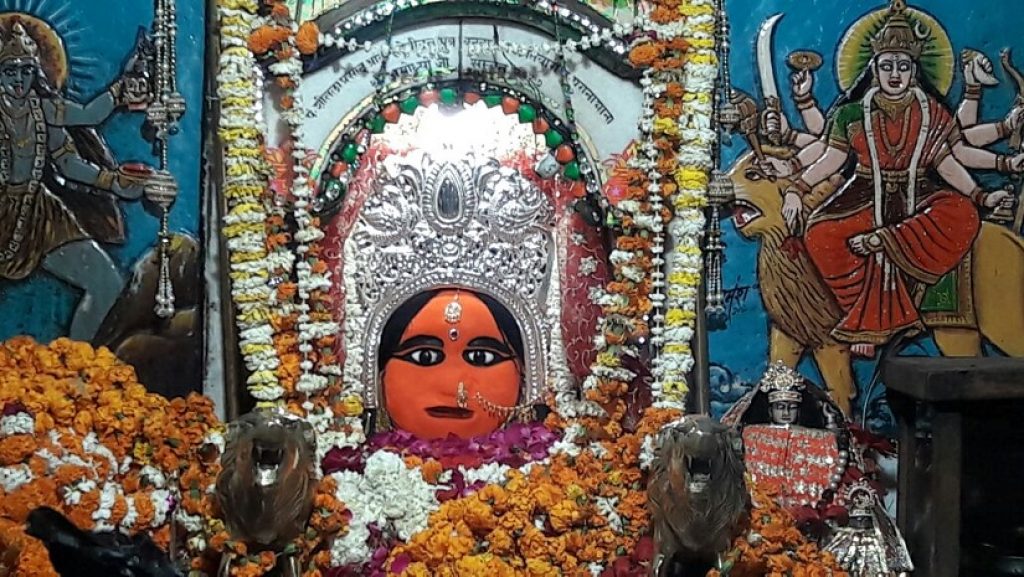
Steeped in tales from the Ramayana, the temple near Naya Ghat was erected by King Dashrath to house an idol of goddess Girija Devi, brought by Mother Sita after her wedding with Lord Rama.
10. Surya Kund
Positioned along the Chaudah Koshi Parikrama Marg, this expansive tank, encircled by ghats and situated 4 km from Ayodhya, was commissioned by the Suryavanshi rulers as a tribute to the Sun god.
11. Sahastradhara or Shri Lakshman Mandir
Situated east of the Papamochana Tirtha, Sahasradhara Tirtha is a sacred location where Lakshmana concluded his earthly lilas; worship at this spot, as per prescribed rituals, is believed to bestow limitless merits. The ancient Lakshmana Temple, located on the banks of Sahasradhara Tirtha, commemorates the spot where Lakshmana sat and meditated before his return to Saket Dham.
12. Shri Gupthari
Marking the culmination of Shri Ram’s divine play, this sacred site is where he concluded his pastimes, entering the Saryu River along with all living and non-moving creatures of Ayodhya, ultimately attaining his supreme abode.
13. Nirmali Kund
Situated to the west of Ayodhya, Nirmalkund in Shri Saryujal serves as a daily pilgrimage spot, where Tirtharaj Prayag comes to take a bath.
14. Shri Manorama teerth
Located on the opposite bank of Shri Saryu Ji, this site serves as the confluence of the Manorama River and Saryu, featuring a temple dedicated to Shri Ram; it holds historical significance as King Dasharatha performed the Putrakameshti Yagya at this sacred place.
15. Bilvahari
Nestled on the banks of the Sarayu River, 16 kilometers east of Ayodhya, Bilvahari ji’s sacred site offers liberation from the triad of debts through bathing and donations, ensuring fearlessness in the presence of the enemy by seeking the divine darshan.
16. Nandigram and Bharatkund
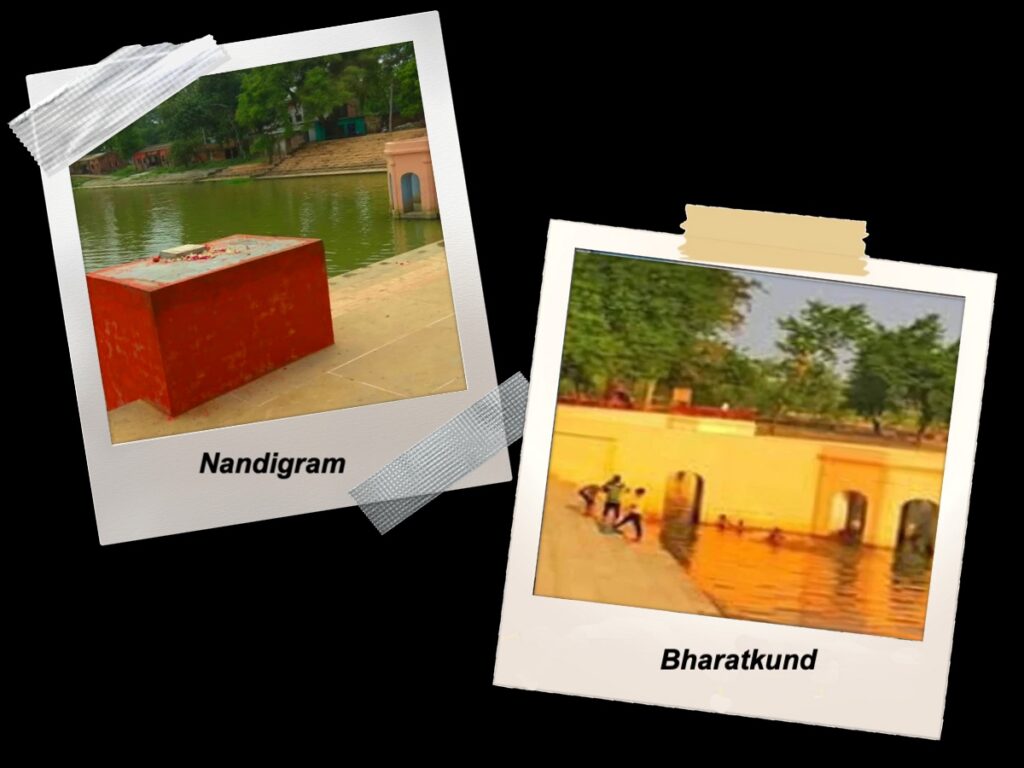
Located 18 kilometers south of Ayodhya, this site is where Shri Bharat ji established Ramcharan Paduka and observed a fourteen-year fast; it was also the place where Shri Ramchandra ji first met Bharat ji upon his return to Ayodhya after defeating Ravana.
17. Vasishtha Kund
Towards the western direction of the birthplace, lies Vashishtha Kund, a pond where Lord Shri Vashishtha resides along with Arundhati.
18. Mani Parvat
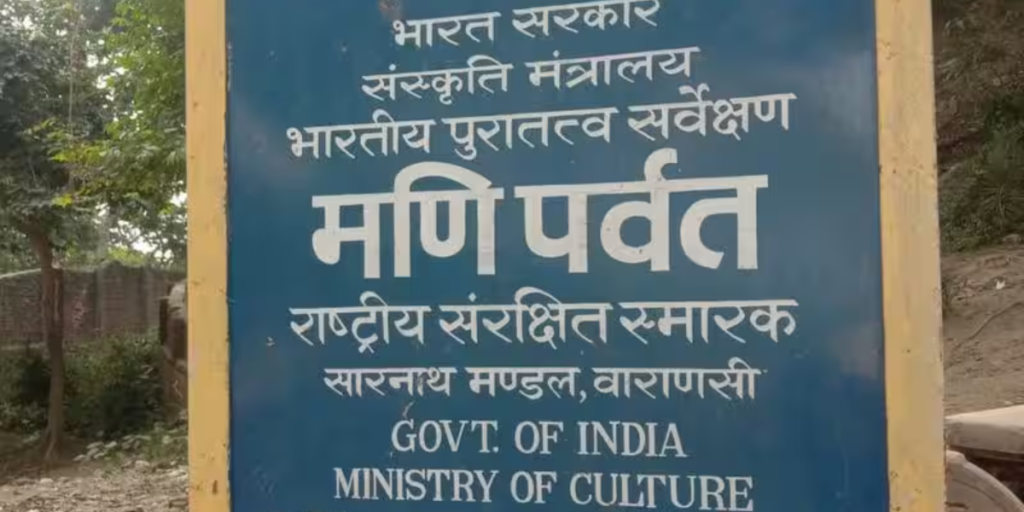
In the western vicinity of Vidyakund lies Maniparvat, a mountain brought by Garuda ji on the orders of Ramchandra ji for the visit of Shri Janaki ji; the mere sight of this mountain is believed to bring complete attainments.
19. Vidya Kund
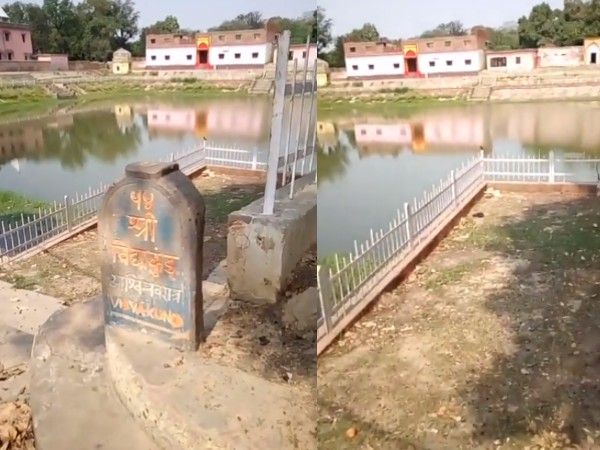
Towards the east of the birthplace, Vidyakund is revered as the site where Shri Guru Vashishtha ji imparted teachings of Chaturdash Vidyas and Chaushat Kalas to Ramchandra ji; it is believed that one attains success in chanting all the mantras of Saur, Shaiva, Ganesha, Vaishnav, and Shakta traditions here.
20. Sita Ki Rasoi
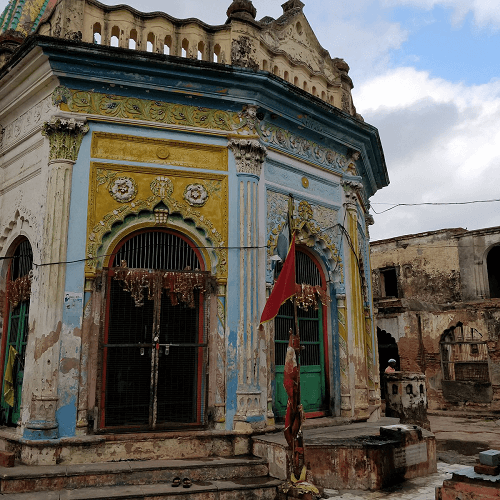
Sita Ki Rasoi, situated near Ram Temple, transcends being just a temple; it stands as a testament to the cultural and culinary heritage associated with Goddess Sita. Thought to be an ancient kitchen used by Sita, the temple features exhibits and idols depicting the holy family of Lord Rama. As one explores this unique site, housed in a basement structure, they delve into the religious traditions and cultural nuances intricately linked to Sita’s revered role, making it a fascinating glimpse into the past.
Timings: 06:00 AM – 08:00 PM
Entry Fee: Free
What to see in Ayodhya?
Ram Ki Paidi

Ram Ki Paidi, a picturesque series of ghats along the banks of the River Saryu, invites pilgrims and devotees to partake in the sacred ritual of bathing in its holy waters, while the annual Deepotsav event, an extravagant display of lights and festivities, attracts thousands to its riverfront. As the ghats illuminate with the radiance of lamps and resonate with devotional hymns, Ram Ki Paidi emerges as a symbolic nexus where spirituality intertwines with the natural splendor of the river. Offering scenic vistas and an atmosphere brimming with religious fervor, this riverfront stands as a must-visit destination for those seeking a profound connection with Ayodhya’s spiritual heritage.
Diwali Deep Mahotasava

Diwali is one of the most famous festivals for Hindus and just one day before of Diwali Ayodhya is fully decorated with Diya which is unique all over the world. A dedicated team of 25,000 volunteers was tasked with lighting over 21 lakh lamps, while the Deepotsav event was overseen by a team from the Guinness Book of World Records, utilizing a drone camera to accurately count the diyas.
Ram Navami Festival
Significant celebrations on this day unfold in Ayodhya and numerous Rama temples across India, featuring Ratha yatras (chariot processions) depicting Rama, Sita, Lakshmana, and Hanuman at various locations; in Ayodhya, the festivities often include devotees taking a dip in the sacred river Sarayu before visiting the Rama temple.
Other famous places to visit in Ayodhya:
Treta Ke Thakur Temple
Choti Chawni
Tulsi Smarak Bhawan
Bahu Begum ka Makbara
Raja Mandir
Moti Mahal
Dashrath Bhavan
Ram Ki Paidi
Ram Katha Park
Gulab Bari
Tulsi Smarak Bhawan
Guptar Ghat
Shri Punyahari
Things To Do In Ayodhya
There are many things to do in Ayodhya, below are some famous activities that will help to add a special day in your life.
- Visit the Tulsi Smarak Bhawan Museum
- Have a Look at Sita ki Rasoi
- Watch a Cultural Show at Ramkatha Park
- Visit Raja Mandir at the River
- See the Famous Mani Parbat
- Enjoy a Walk in Moti Mahal
- Pray in the Caves of Choti Chawni
- Explore the serene beauty of Bahu Begum ka Maqbara with a stroll through its historic grounds.
- Savor the tranquil ambiance and spiritual vibes at Ram ki Paidi as you take in the scenic surroundings along the banks of the sacred River Saryu.
- Visit Temples on the Ghat
Tips which will help when you visit in Ayodhya
- In the Ramjanmbhoomi campus (Ram Temple) you cannot take your things such as Mobile phones, chargers, pens, notebooks, and smart watches), campus locker facilities are available for free.
- E-buses are being introduced for the entire city. Apart from this, a golf cart will also be available, the rental of which will be ₹50 per person.
- Based on the weather the best time to visit Ayodhya is March to May and October to December.
- Lift and wheelchairs are available for old and disabled devotees inside the Ram Temple.
- Just outside of the Ram Temple, there is Ram Rasoi. The devotees who visit the Ramlalla temple they can get the free food by showing their Aadhar Card here.
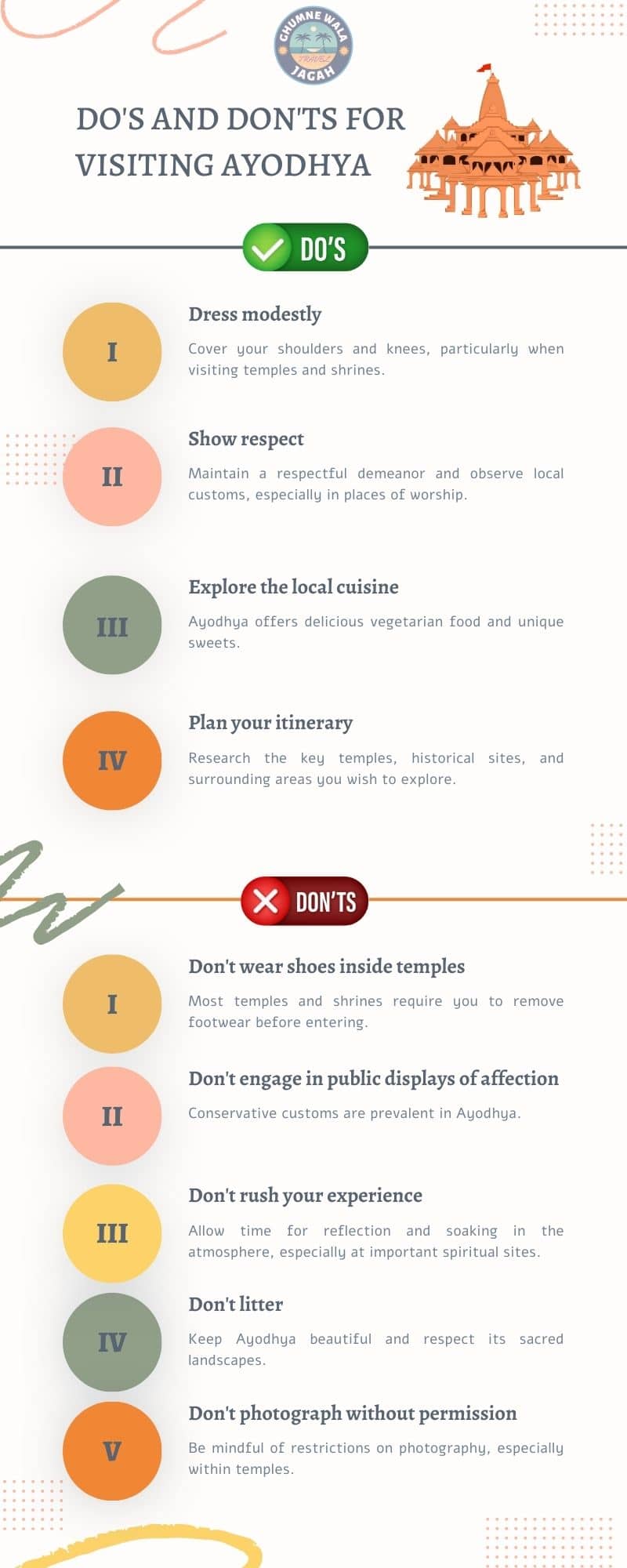
Important Note: Political and religious tensions can still exist in Ayodhya. Stay aware of your surroundings, exercise caution, and always prioritize respect for the local people and their customs.
Conclusion
Ayodhya’s sacred sites, vibrant culture, and welcoming spirit create an unforgettable experience for any traveler seeking historical, spiritual, or cultural immersion.
Read Also: Places to visit in Uttar Pradesh
FAQs:
Question. Are there vegetarian options in Ayodhya’s cuisine?
Answer: Indeed, Ayodhya’s culinary offerings are predominantly vegetarian, mirroring the cultural and religious influences that define the city’s gastronomic landscape.
Question. Is Ayodhya safe for solo travelers?
Answer: Ayodhya is widely regarded as a safe destination for solo travelers, although it is recommended to exercise standard safety measures and maintain awareness of one’s surroundings for a comfortable and secure experience.
Question. What is the significance of Ram Navami in Ayodhya?
Answer: Ram Navami is celebrated with grandeur in Ayodhya, marking the birth anniversary of Lord Rama, as the city comes alive with vibrant processions, traditional rituals, and cultural events.